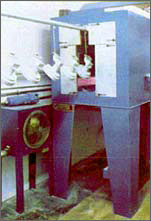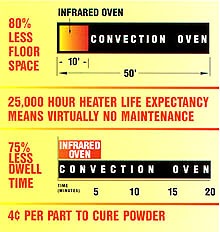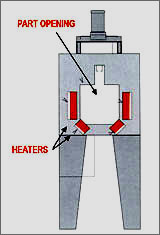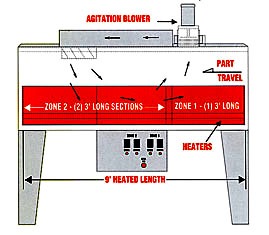Case Study
Wisconsin Infrared Systems
Wisconsin Infrared System’s infrared/convection combination heater conserved floor space and increased line speed.
Background
The customer was originally using a batch oven to cure the powder on satellite amplifiers. This process had several drawbacks including slow production, poor coating consistency and an inflexible oven design.
After time, it was necessary to upgrade the oven to achieve higher production rates. Several optional oven designs were reviewed such as a larger batch oven, a continuous gas convention oven and a continuous medium-wave electric infrared oven.
After careful consideration, it was decided that a larger batch oven could obtain the desired production but had too many other drawbacks (as noted above). The continuous convention oven required more floor space than was available to obtain the desired production rate.
The medium-wave electric infrared oven achieved all of the goals for a new curing oven:
- faster production
- minimal floor space
- reduced maintenance requirements
- low energy consumption
- reasonable capital expenditure
- flexibility for faster production rates in the future, accomplished by sectional oven design

Batch Oven
Advantages of using infrared for this application:
Floor Space
It was estimated that a 40′ – 50′ long convection oven would have been required for this application. The infrared oven length is 10′. Both ovens require a 15′ area for the loading and unloading of the parts.
Maintenance
A gas convection oven requires preventive maintenance several times a year. The infrared oven has been installed for 2 1/2 years with no requirement for maintenance to date. With a typical life expectancy of 25,000 hours for Solar Products’ panel heaters, the customer will be operating for a long time without experiencing any maintenance problems.
Line Speed
A gas convection oven would have required a 20-minute dwell time. The original infrared oven design was based on a line speed of 1 fpm and a dwell time of 10 minutes. In actual operation, the conveyor speed is 1.5 fmp with an oven dwell time of 5 to 7 minutes.

Energy Consumption
The input power rating is often viewed as the actual power usage for an electric infrared oven. In this case, the oven required 70 kW of electric infrared energy. But, in actual operation, its energy usage is less than 30 kW. The energy cost calculation is 30 kW x 12 cent per kW/hr =$3.60 per hour of operation. At 90 parts per hour, that equates to four cents per part. The energy consumption for paint and powder applications typically accounts for less than 1% of the product selling price. Our guess is that four cents is well below the 1% margin. The best part about Solar Products’ panel heaters is that there are no external reflectors. External reflectors only get dirty over time reducing heater efficiency. Solar products’ heaters maintain a consistently high radiant efficiency (80%) over time.

Heater Insertion
| Specifications | Part Details |
| Part Description | Aluminum or magnesium cast parts variable wall thickness |
| Part type | Satellite dish amplifiers for the communications industry |
| Coating | Polyester powder |
| Coating application | Manual electrostatic spray |
| Length of oven | 10′ long oven |
| Zones per oven | Two zones – 9′ heated length for both zones |
| Zone 1 | One 3′ long section operating at 900o F |
| Zone 2 | 3′ long sections operating at 875o F |
| Oven type | Infrared with air assist |
| Heater type | Solar Products’ F-Series panel heaters |
| Input power | 70 kW for the heaters |
| Actual power | Usage Less than 30 kW |
| Conveyor type | Overhead monorail |
| Conveyor speed | 1.5 feet per minute |
| Weight of part | 5 lbs max |
| Production rate | 90 parts per hour |
| Gel and cure time | (dwell time) 5 – 7 minutes |
